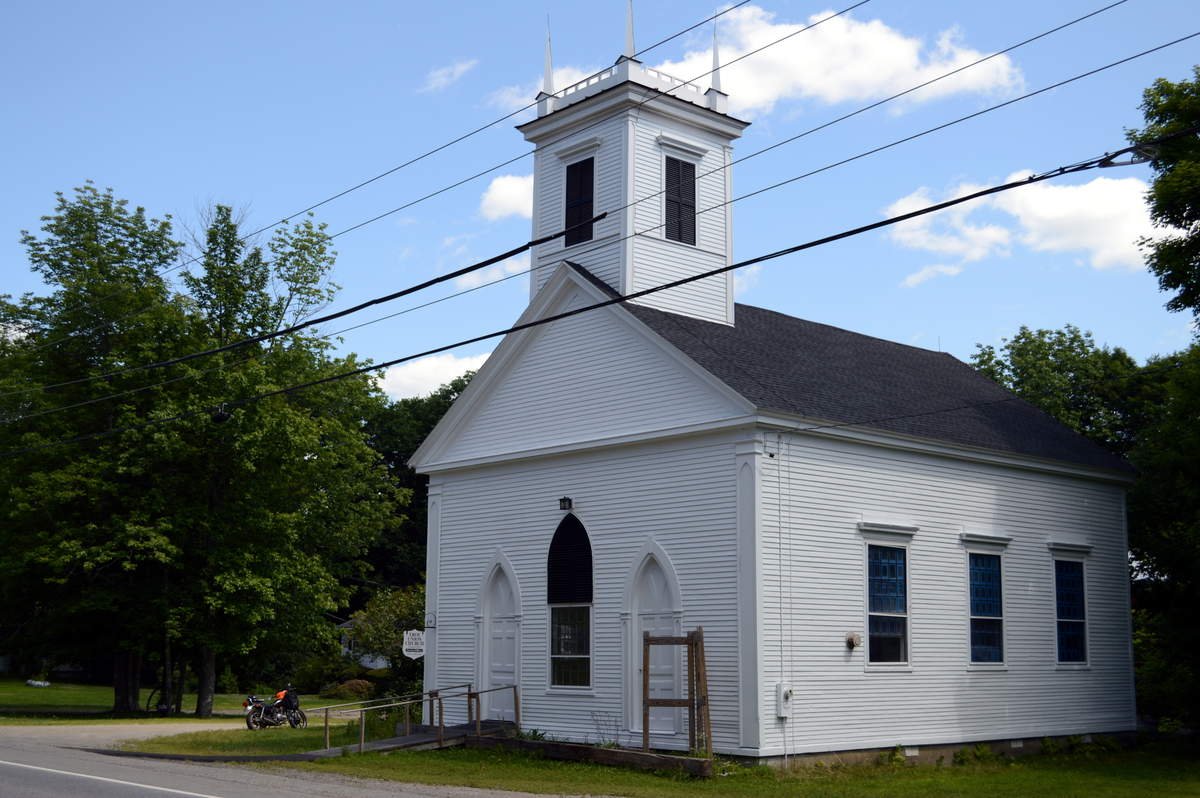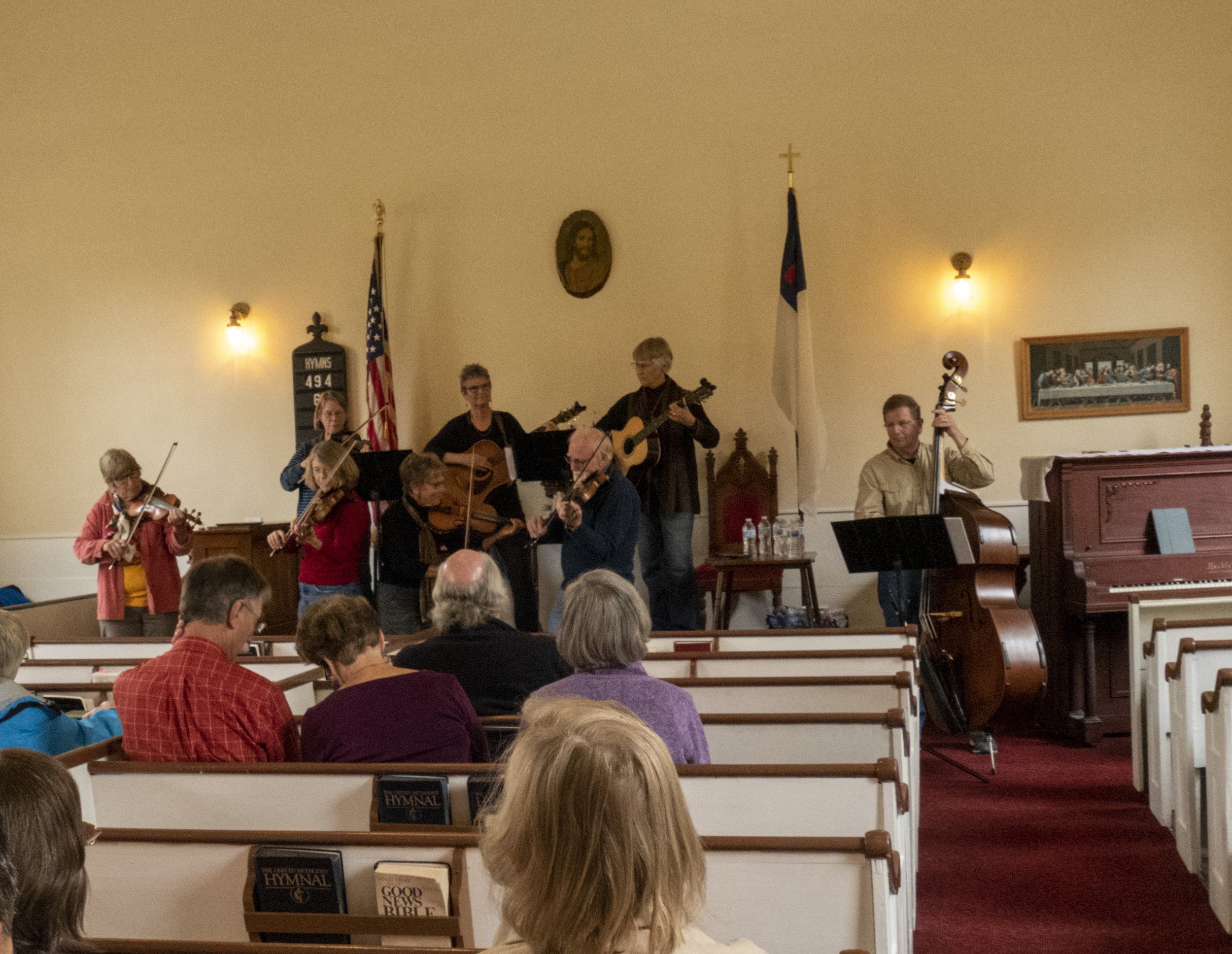It takes courage and determination to save a meaningful place. Thankfully for the residents of Troy, Norma and Greg Rossel have both, plus an innate appreciation for old buildings. When it was discovered that the future of the town’s only true meeting space, the Troy Union Church, was in jeopardy, the couple stepped up. They started with a donation jar at the local general store.
The Troy Meeting House Society constructed the building in 1840 as a Union Church. The group of Troy residents raised funds and sold pews to create a non-denominational space that could be used by all. The white, rectilinear building features a mix of architectural details, a prominent box belfry with four spiralets on the front portion of the roof, and a relatively unadorned interior. The overall form, closed cornice pediment, wide frieze, corner pilasters and projecting window hoods all point to the Greek Revival style, while inset lancet arch and tracery motifs on the pilasters, trim, and doors exude hallmarks of the Gothic Revival style. General maintenance kept the building in working order for more than 150 years, but serious issues like a leaning steeple were left unresolved for several decades. Reality set in in the early 2000s and it was either fix it or lose it.
The easiest path for the small membership would have been to let gravity and mother nature run their course. The Rossels had a different plan. They weren’t going to give up on the landmark down the road from their home. Looking back on the project, Greg proclaimed that “buildings say a lot about common aspiration, ambition, and pride. 175 years ago, citizens together fashioned a classical landmark that was grander than any of their individual homes, barns, or shops and placed it on a high spot on a main road so all could see it. It said – we are a town.” They may not have known it, but the Rossels were working to preserve something larger than a building, they were sustaining community through a common cause. They forged the path and won supporters along the way.
Norma served as the Restoration Project Coordinator, while Greg assumed the role as chair of the restoration campaign. Having been a member of the Troy Union Church for over 40 years, Norma was no stranger to the structure’s storied past. With help from Christi Mitchel at Maine Historic Preservation Commission, they researched and successfully nominated the church to the National Register of Historical Places (2011). Their responsibilities were all encompassing – project management, fundraising, and communications. Norma took advantage of her newly acquired grant writing skills from participating in Maine’s Encore Leadership Corps (ENcorps) and managed willing volunteers. Greg, a boatbuilder by trade, developed the scope of work, coordinated contractors, and documented every detail of the project from start to finish. He remarked that when you take something apart, you probably should have an idea of how to put it back together!
Using visual evidence from historic postcards, the group was able to restore the church to its original appearance. The work spanned several phases and amounted to precision surgery on the church. Lead contractor, Preservation Timber Framing, first had to remove the entire tower to access and remove the damaged king truss, central to the roof structure of the church. They then lowered in a new truss system that was constructed adjacent to the church that improved upon the original design. Lowering the tower back atop the church marked a great victory for the project’s supporters.
Local carpenters worked alongside Preservation Timber Framing to learn about the basics of timber frame construction. Project volunteers also had to remove the 20th century drop ceiling that had put stress on the failing structure. Students from nearby Mount View High School and Unity College volunteered removing layers of wallpaper to uncover the original plaster. Locals contributed to the effort, with the use of locally-sawn timber, copper work atop the steeple, hand carved wood trim for the tower, window restoration, and preservation of the original plaster.
The momentum and outreach generated at the local level attracted support from across the state. The Maine Steeples Fund supported an initial assessment of the building and two subsequent phases of restoration, totaling over $60,000. Further grant support came from the Maine Community Foundation, Morton-Kelly Charitable Trust, and the Leonard C. & Mildred F. Ferguson Foundation. Altogether, the Rossels and company secured over $100,000 in grants. More importantly, those grants were matched by $190,000 in individual gifts, an impressive fete for a preservation project of any size! [Volunteer labor was estimated at an additional $30,000.]
By the time Troy Union Church was restored, hundreds from the community and church had contributed to the effort, but it would not have been possible without the fortitude and leadership of Norma and Greg. A restored Troy Union Church fills a central need as the only space for community meetings, performances, and events in Troy, echoing the reason for its inception in 1840 – once again putting Troy back on the map.








